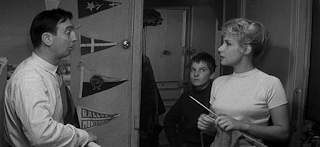Water is a film
that sheds light on the lives of women in India, specifically widows. The
writer and director of the film, Deepa Mehtha, does an outstanding job of
weaving together the lives of various widows, showing their struggles with
religion and current modern values. As a widow in India, they have three
options. The first being they can throw themselves on their husband’s funeral
pyre. Second, they can marry their husband’s younger brother. Lastly, the widow
can live a life of self-denial in seclusion in a village or home with other
widows. The film weaves in the Indian culture and also can be related to the
Indian myth of Krishna and Radha. Through out the film we see elements of this
myth, and being able to analyze why the myth was used will helps to greater
understand the film Water.
The story
of Krishna and Radha is that of the ultimate love story. They are childhood
friends who fall in love. Radha is a cowherd girl in the village, and is
infatuated with Krishna, a herdsman, whom other women lust after. Radha was
dear to Krishna, and they were a devoted couple. He is known to play the flute
as they dance together and sing showing their love and affection. Their love
story is not that of the typical love story, as the two never end up together.
Krishna leaves to pursue studies, and Radha marries another man. Krishna goes
on to have many wives, and each of them worships him. The myth states that
Krishna dies, and his many wives throw themselves at his funeral pyle. However,
spiritually the two are always connected and are the epitome of love in Indian
culture, and their love is based on a deep friendship.
In the version of the story used,
Radha refuses to get married to Krishna. This related to the film of Water. While Kaylani wanted desperately
to marry her true love Narayan, the fact that she had to sleep with his father
tarnished her dreams, and in turn she feels inadequate to marry him, and sadly
takes her own life. This can be related to the myth because Radha did not marry
Krishna as she did not feel good enough to be his wife, the cowgirl would not
fit into his life. Kalyani embodies this viewpoint as she takes her own life,
knowing no matter what she does she cannot live up to what she believes Narayan
deserves. We see this connection in the visual style of the film. Narayan wears
a lot of light blue and white, which symbolizes trust, and spirituality. This
is important because Kalyani trusts and loves him, but a large part of their
relationship is the struggles with spiritual beliefs. When Kaylani realizes who
Narayan’s father is, they are in a boat on the river. They are between his home
and the village. The shot is a long shot and we see them directly in the middle
of the river. This represents the differences between the two individuals. We
are then brought to a close-up shot. We can see the love in their faces and the
passion. However, the viewer gets the sense that they still cannot be together.
The way the film is shot shows the separation and differences visually and
figuratively between the characters, and can be tied in with the myth.
Music is another component that
conveyed the myth through the film. Krishna is known for playing his flute as
an expression of passion and love. We see Narayan play the flute in close-up
shots multiple times in the film, which helps the viewer make the connection to
the myth. This is a clear connection to the story of Krishna and Radha, and the
music links the film to the myth of eternal love. It is important to note flute
music plays in the background when Kaylani takes her own life. It conveys the meaning
of the myth that true love never dies. The flute is Narayan expressing his
sorrow and love and the music of the flute demonstrates this and relates to the
myth.
The director may have chosen to
include elements of the traditional Krishna and Radha love story because it is
a large part of the Indian widow culture. Even in the film we see close up
shots of figurines of Krishna. Widows worship him and this not only relates to
the myth but also shows Indian culture. Adding the myth also challenges the
viewer to analyze and question the values of Indian widow culture. Knowing the
myth we believe in this ultimate love story, that even if a marriage never
occurred, Krishna and Radha hold a spiritual and mutual love for one another
always. Understanding this myth, we see that Krishan has multiple wives, yet
each wife can only have him. With the director incorporating this myth we see
the values of each role of men and women in the Indian culture. Women have one
love, and that is it, where as men are free to have many loves. Showing
elements of the myth of Krishna and Radha in Water we question the values of Indian widow culture. They worship
an epic love story, yet for many of them their love stories ended tragically
and they are no longer able to seek love and happiness.
This film
did a fantastic job of bringing in visual elements to convey the story, as well
as relate to the myth. The director does an excellent job of shedding light on
the widow culture of India, while showing a love story with deep meaning.













